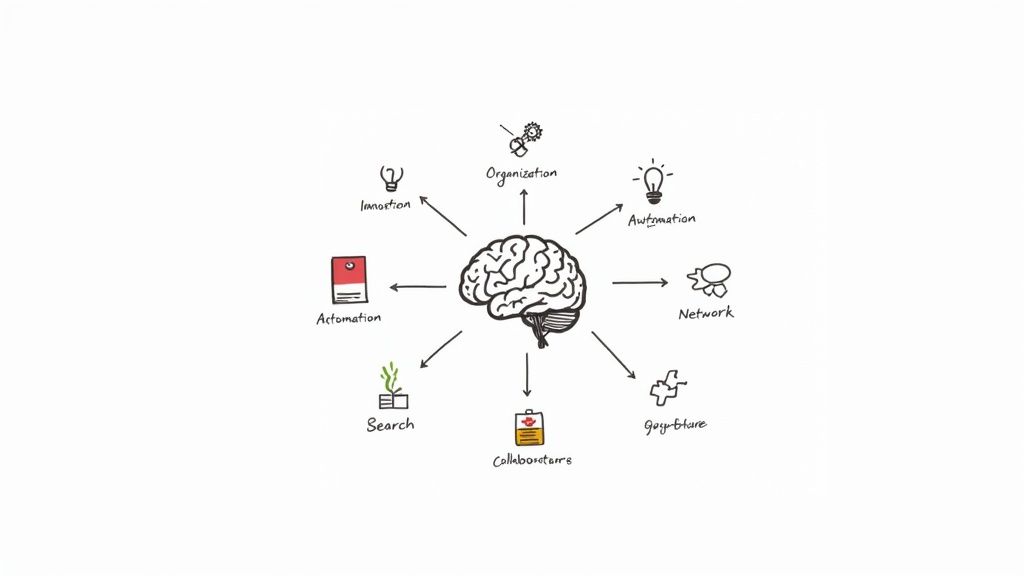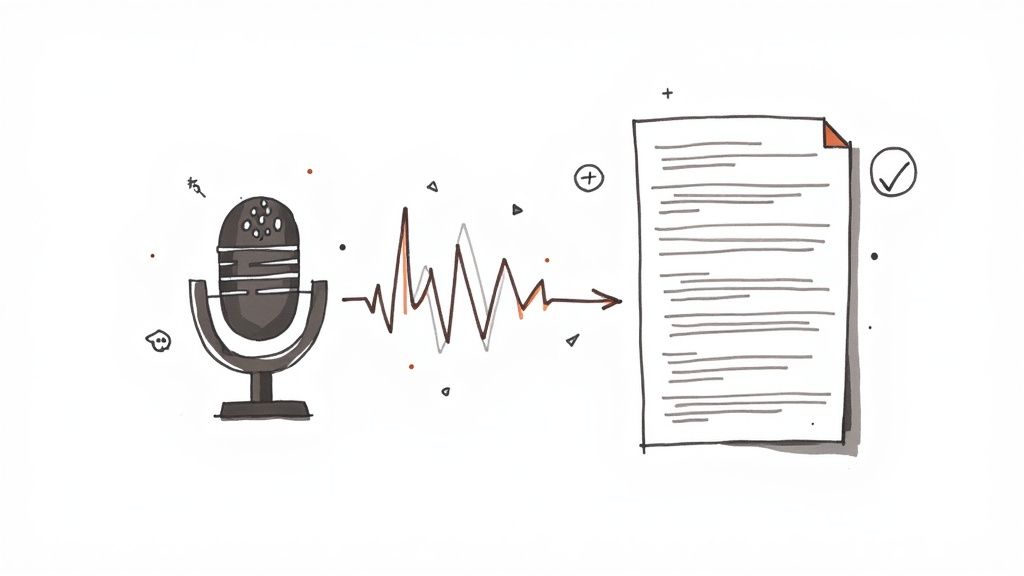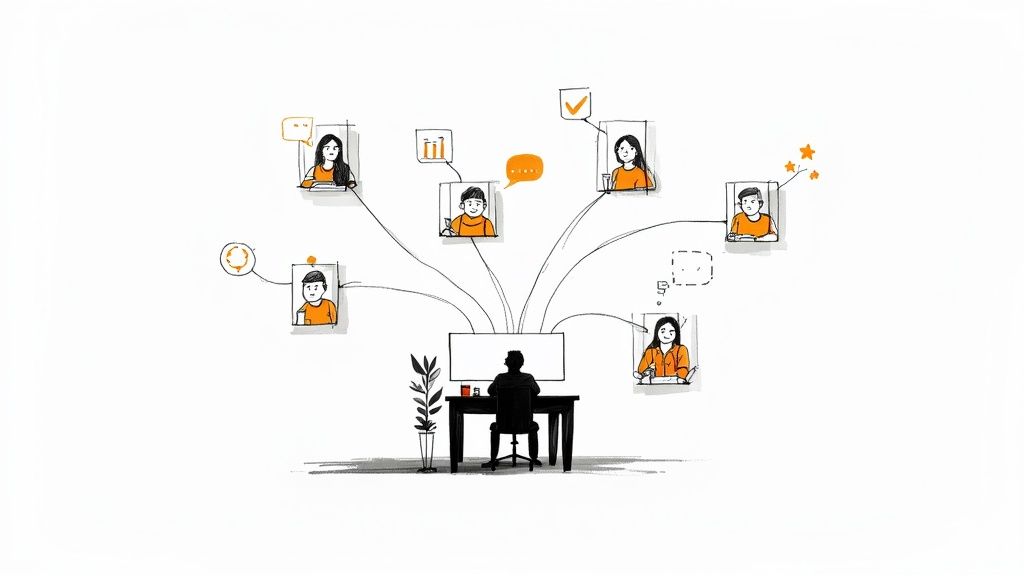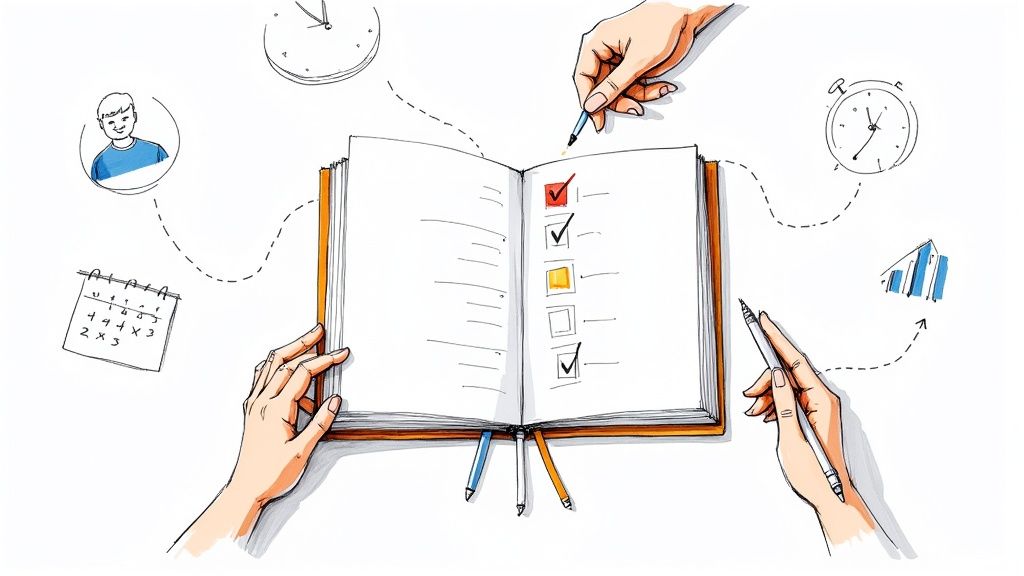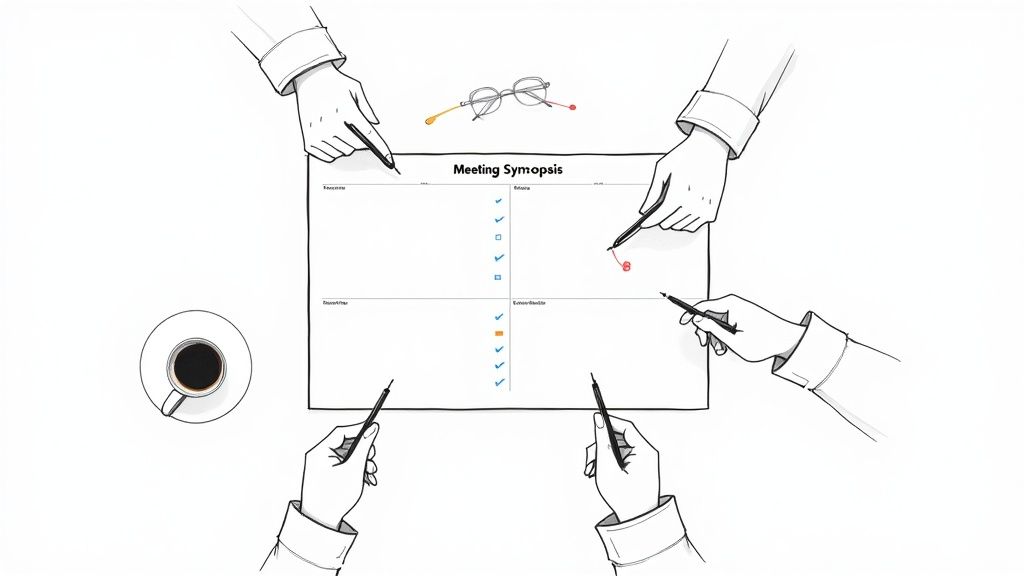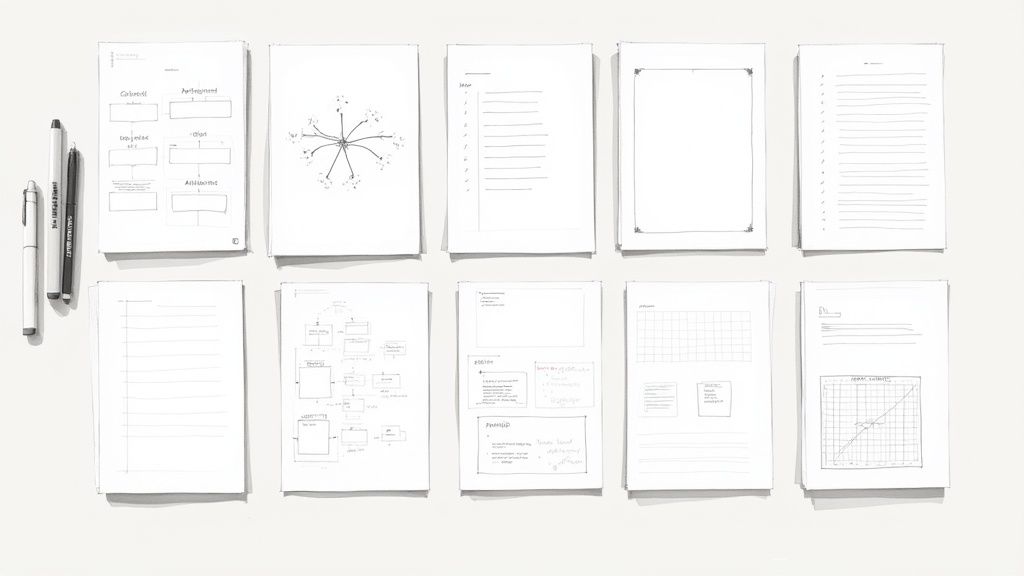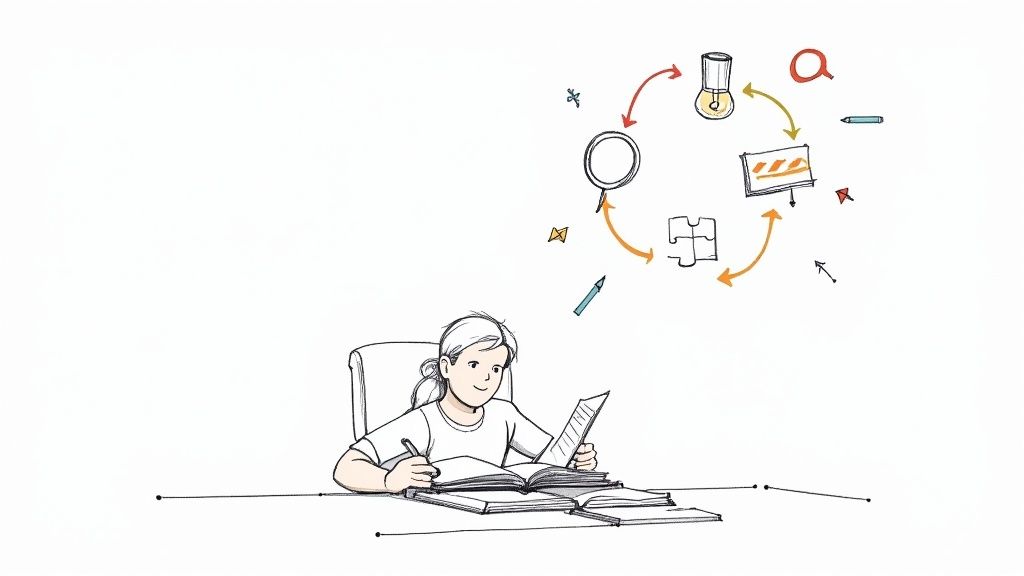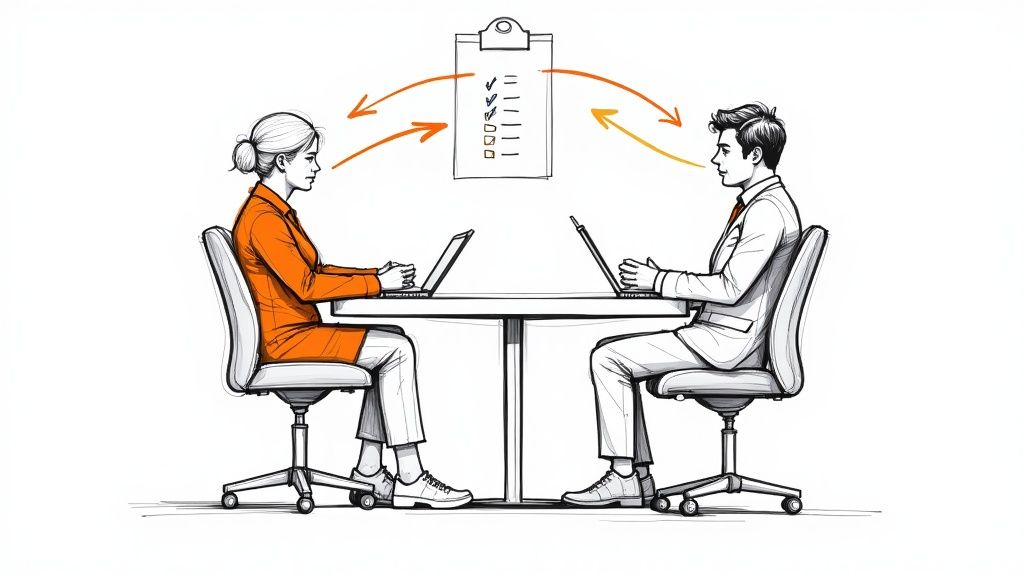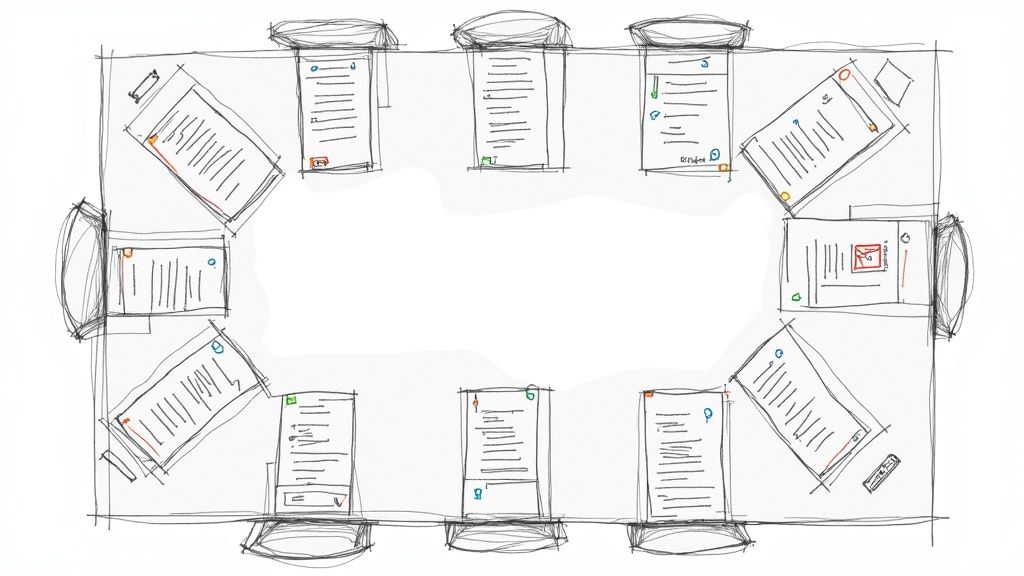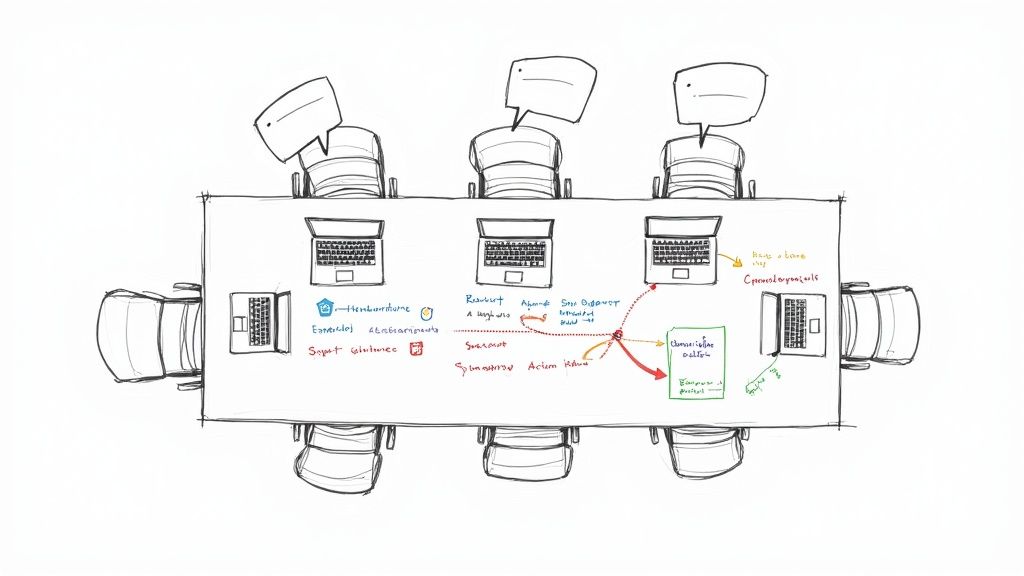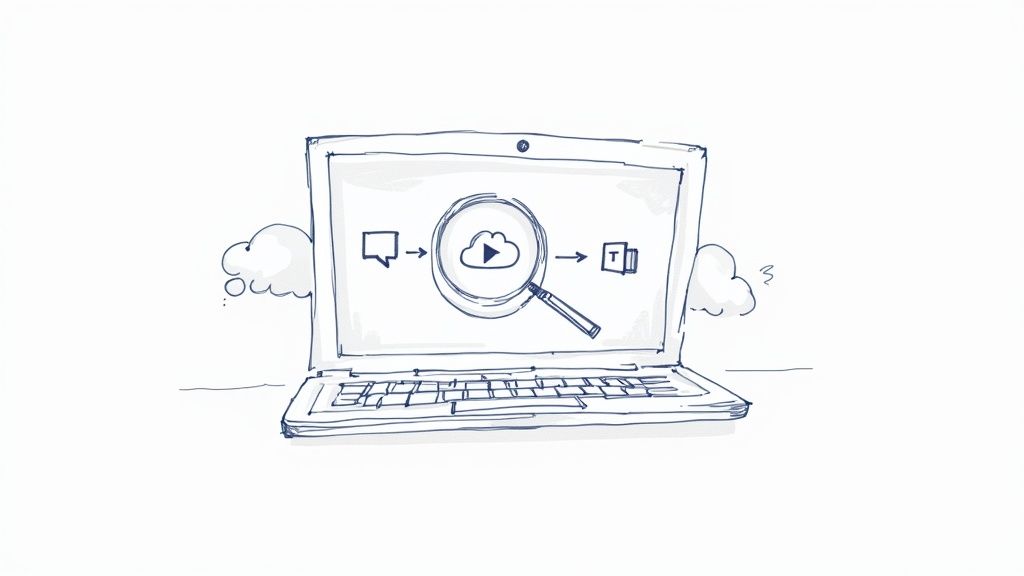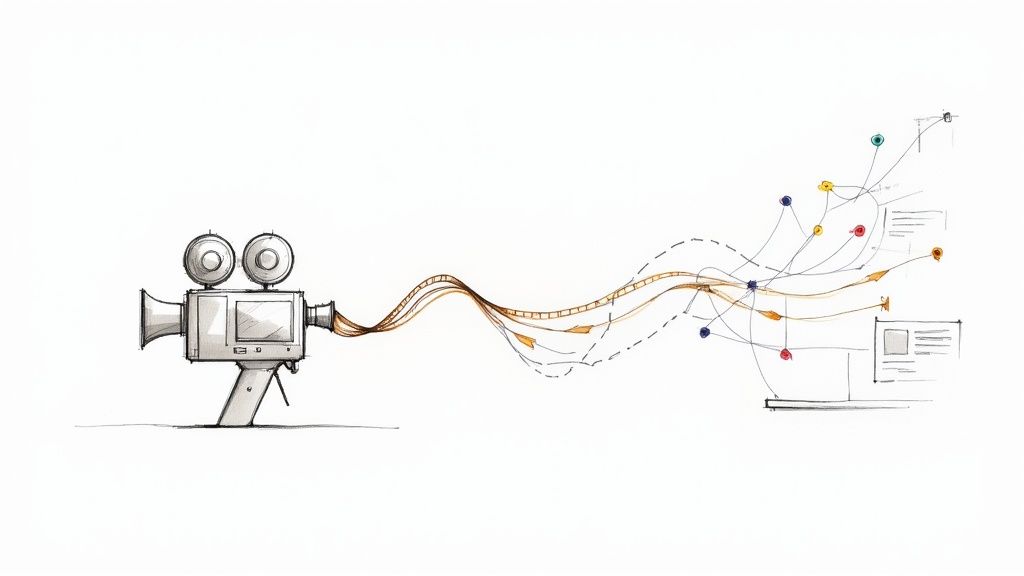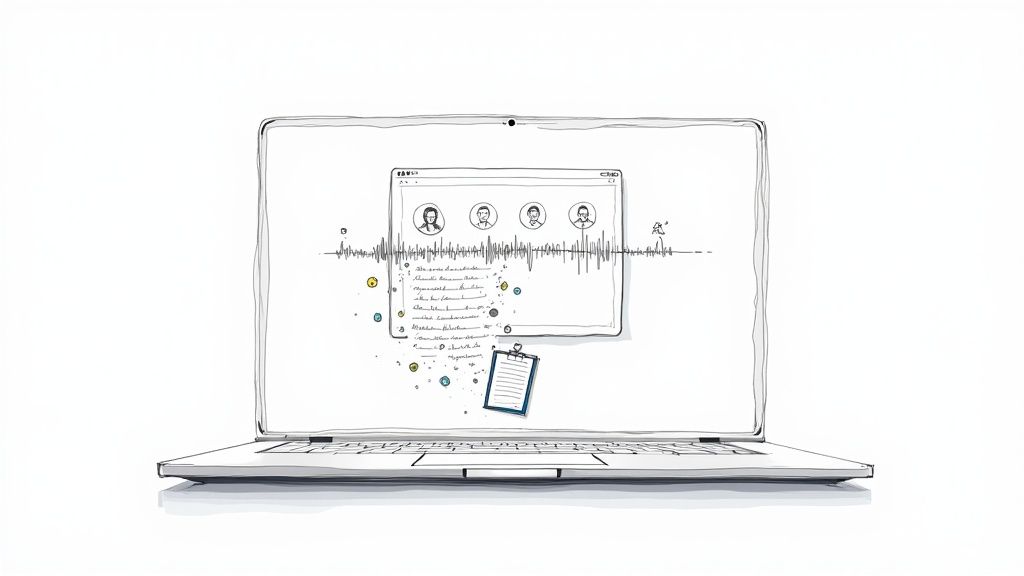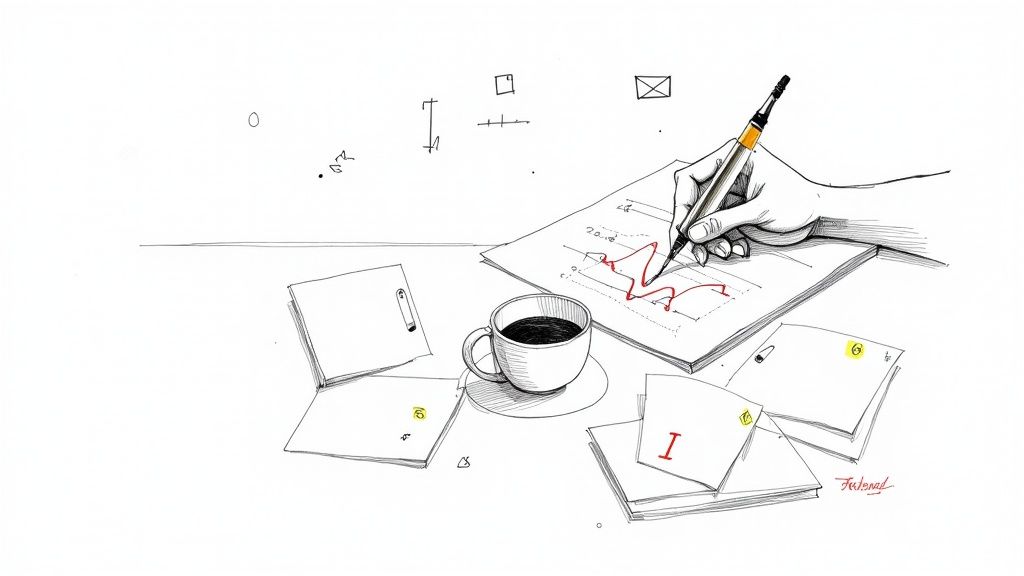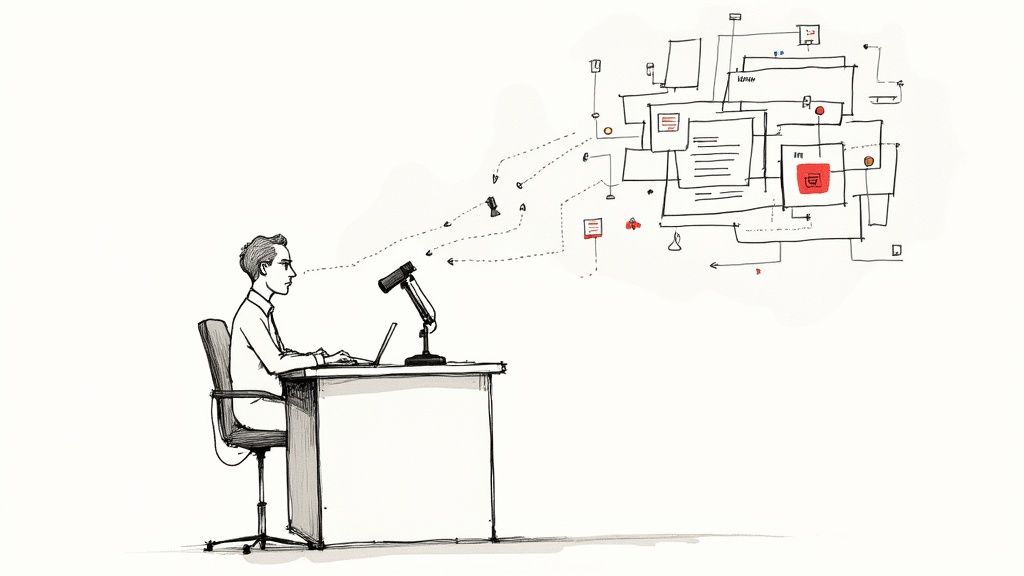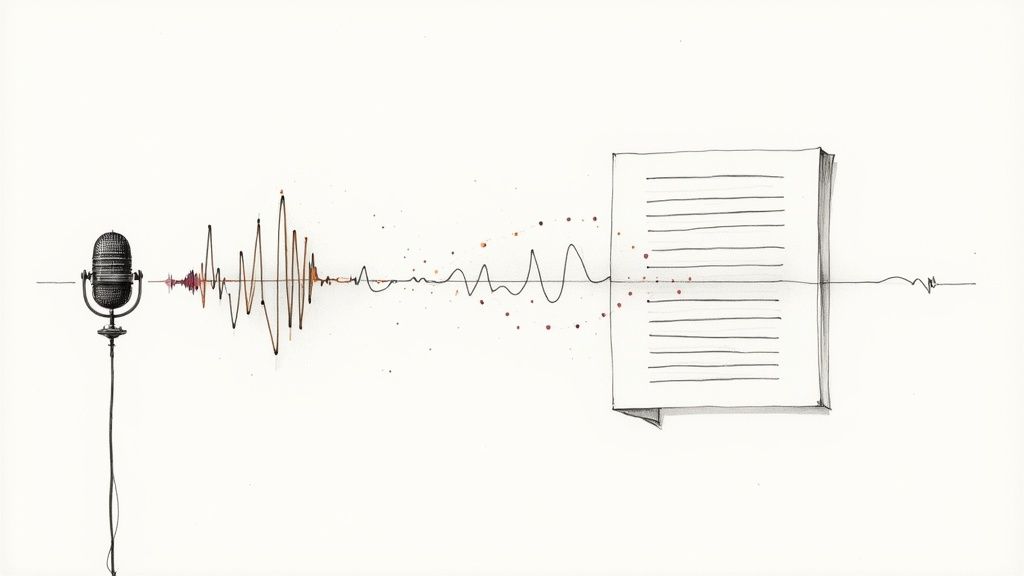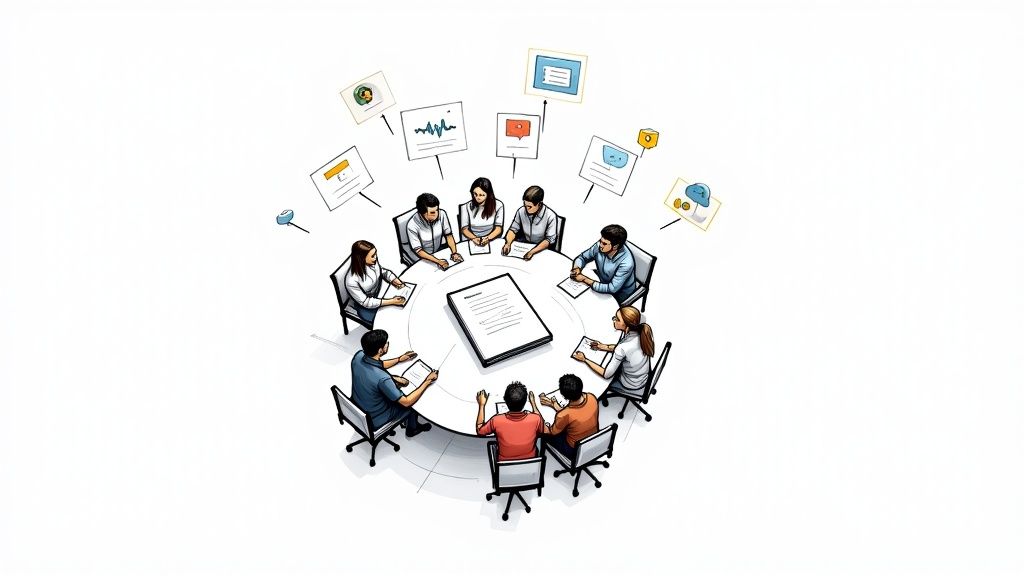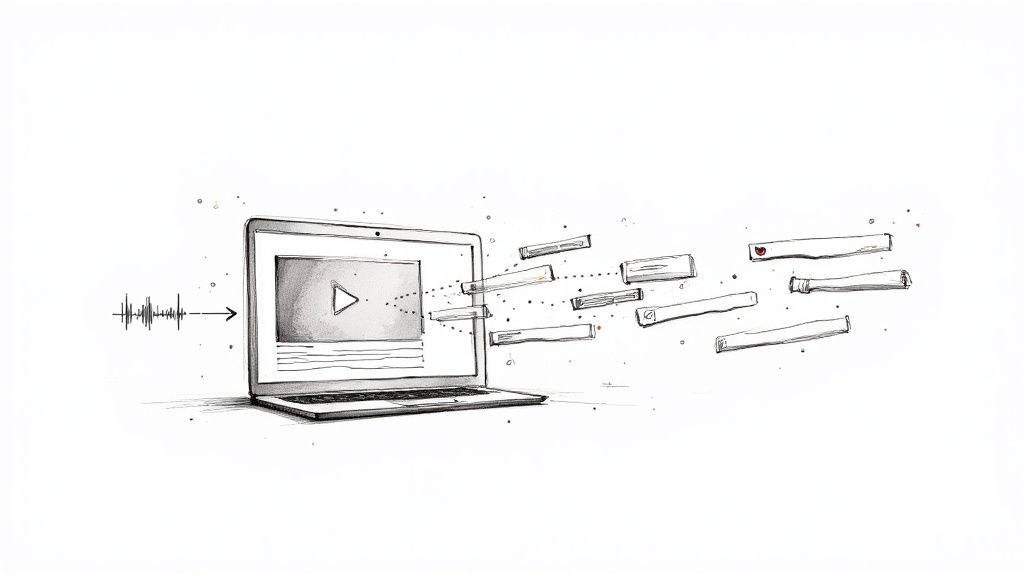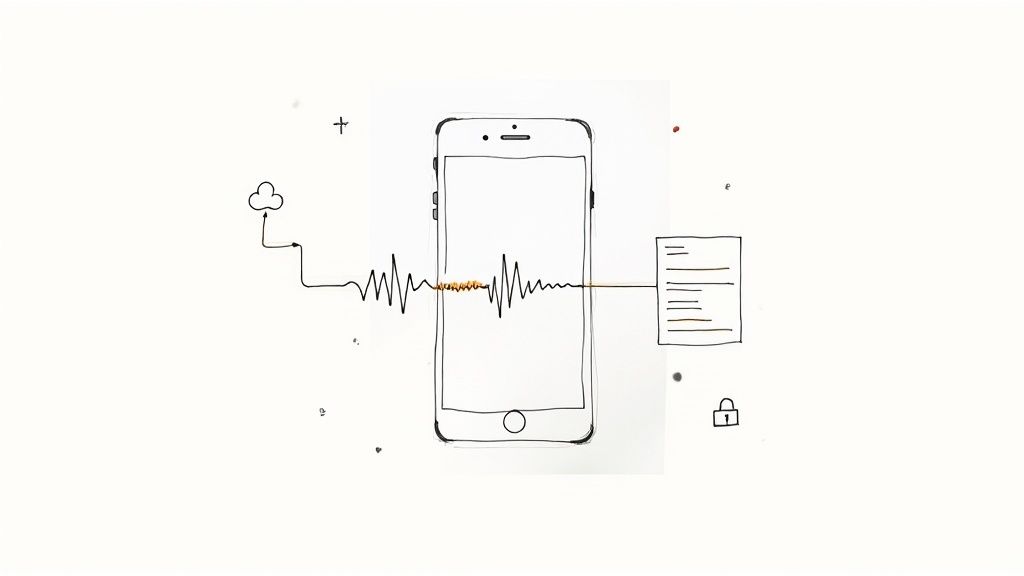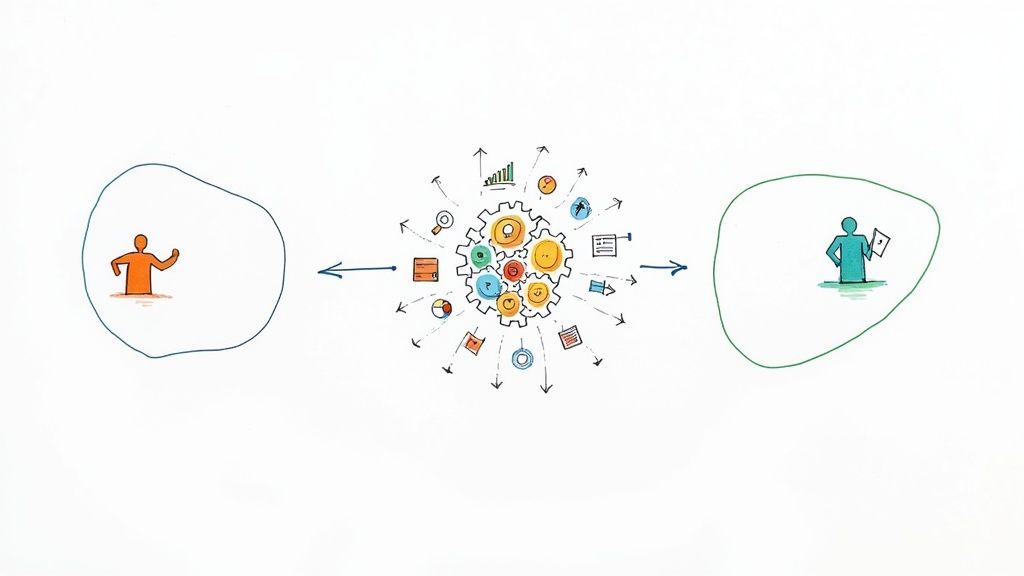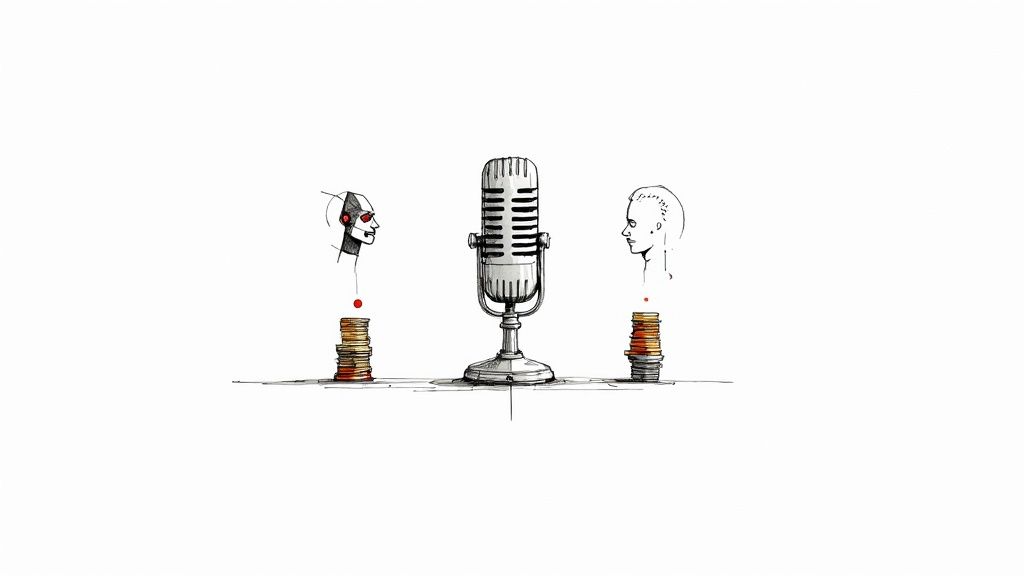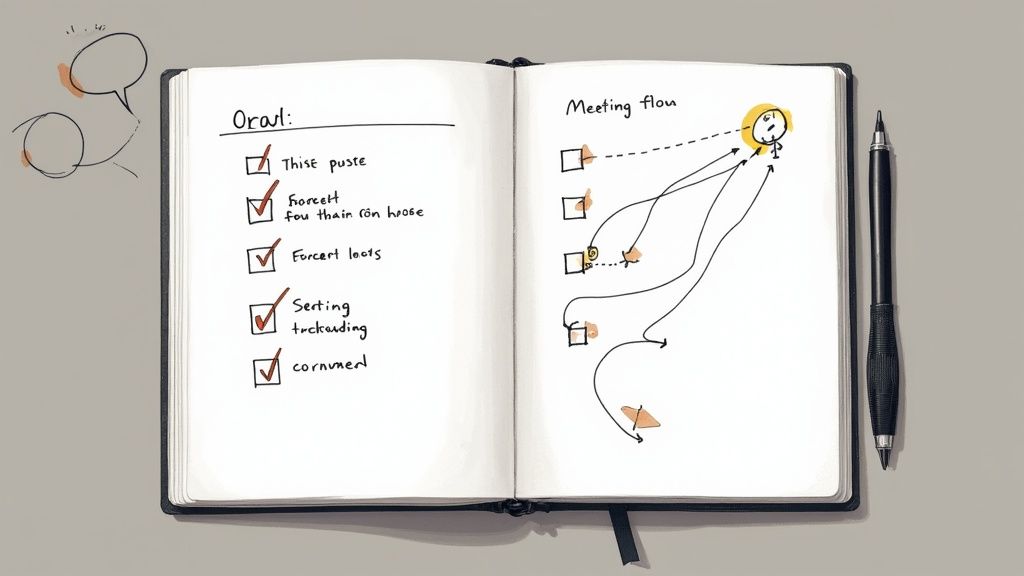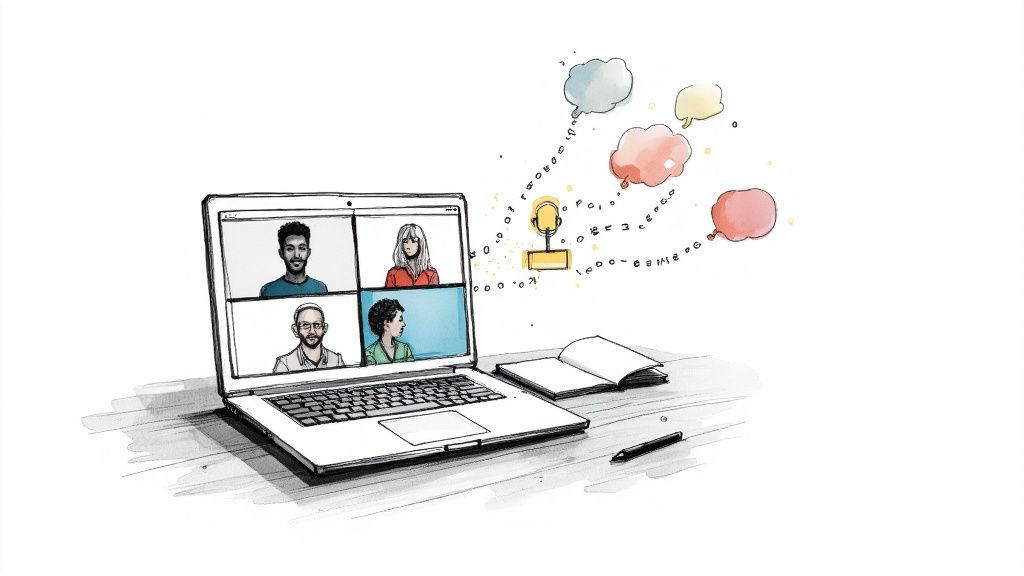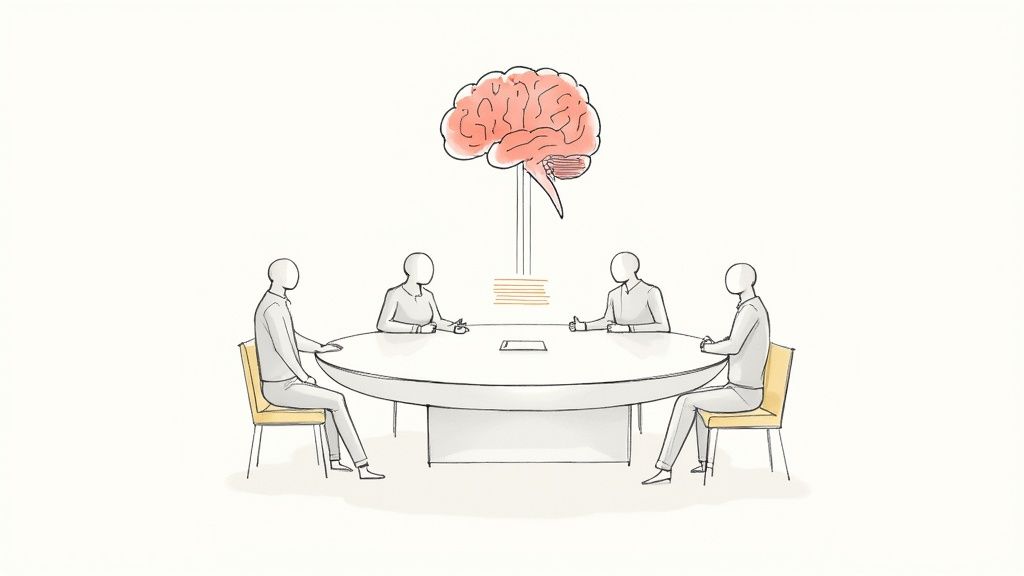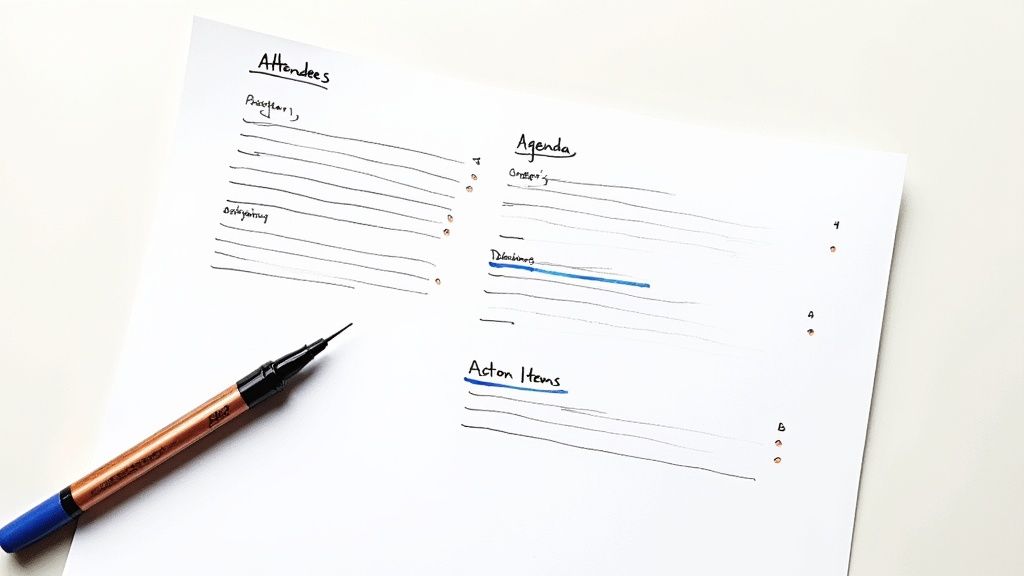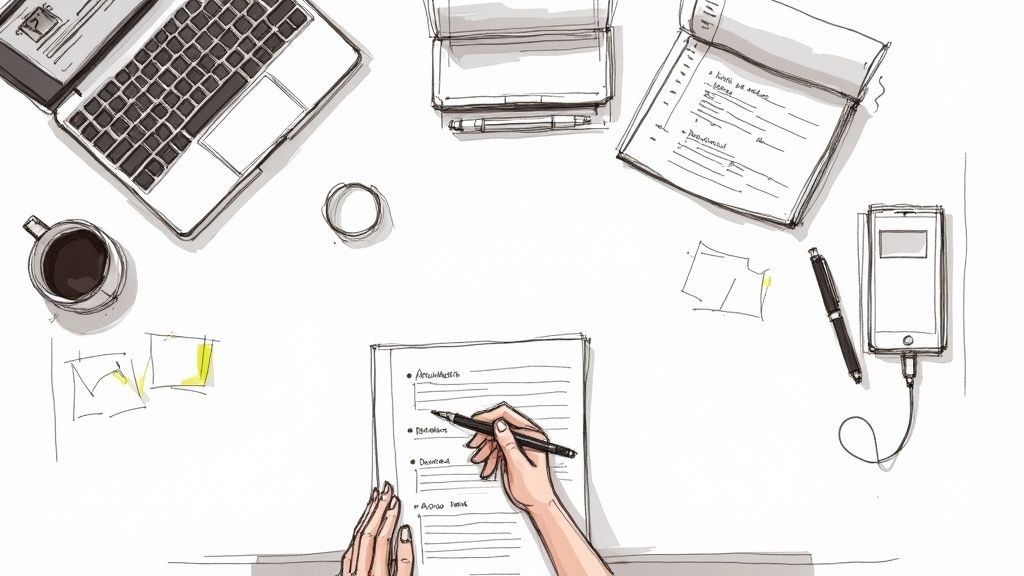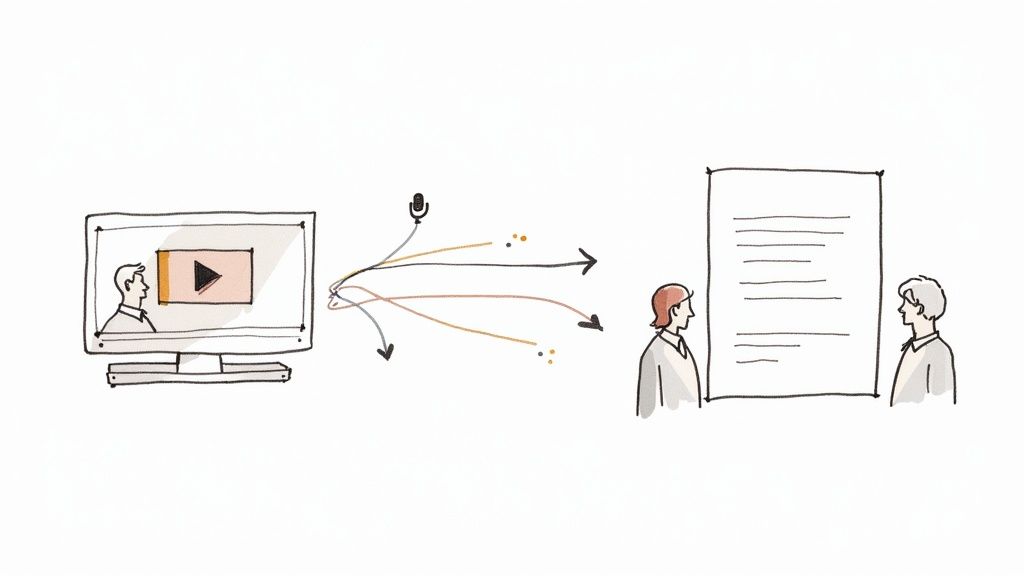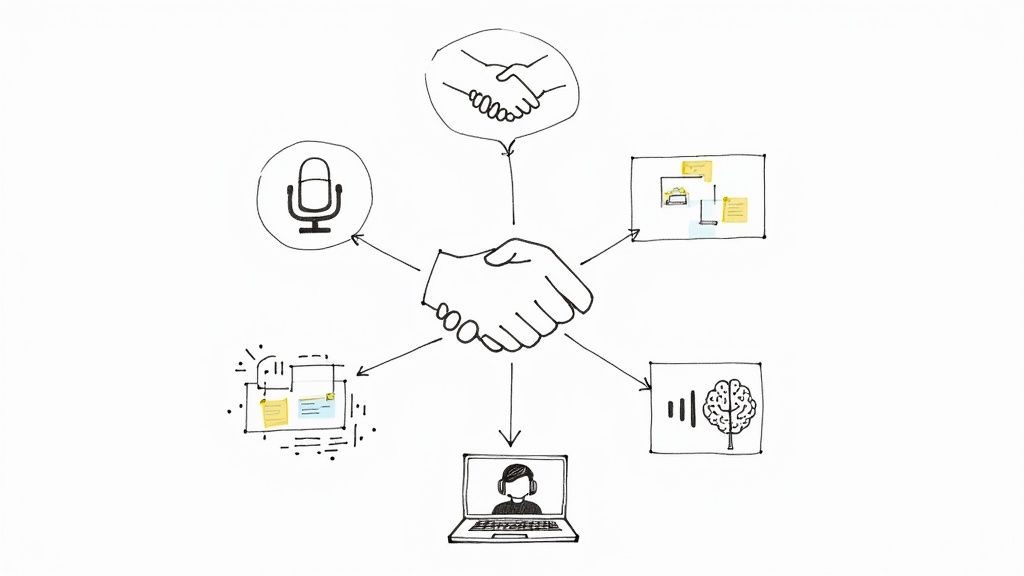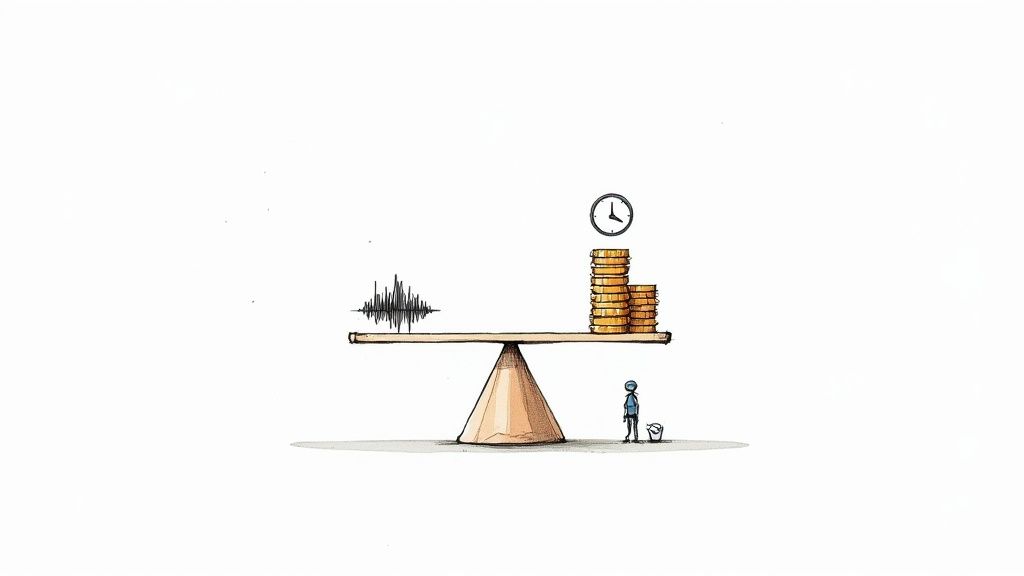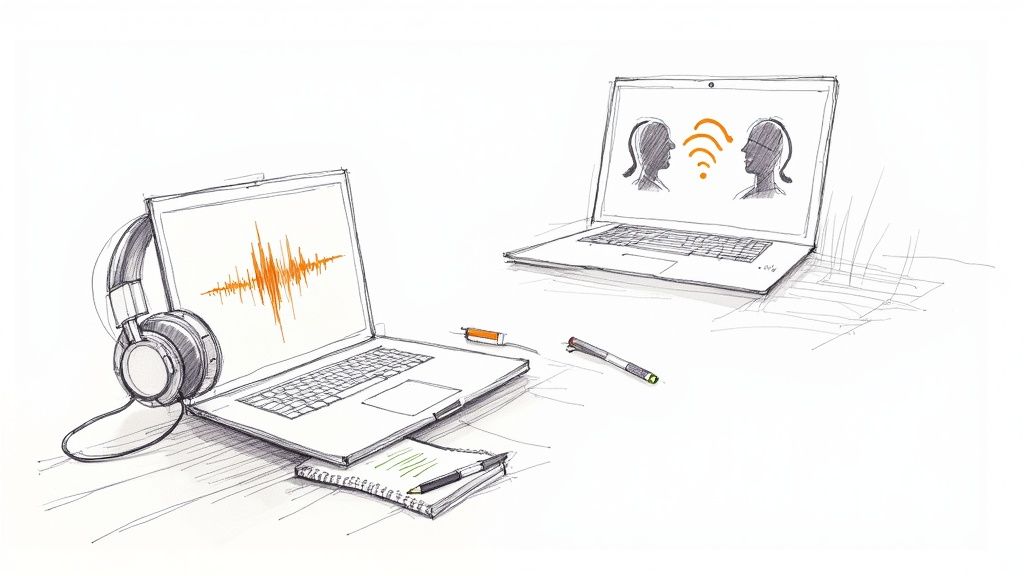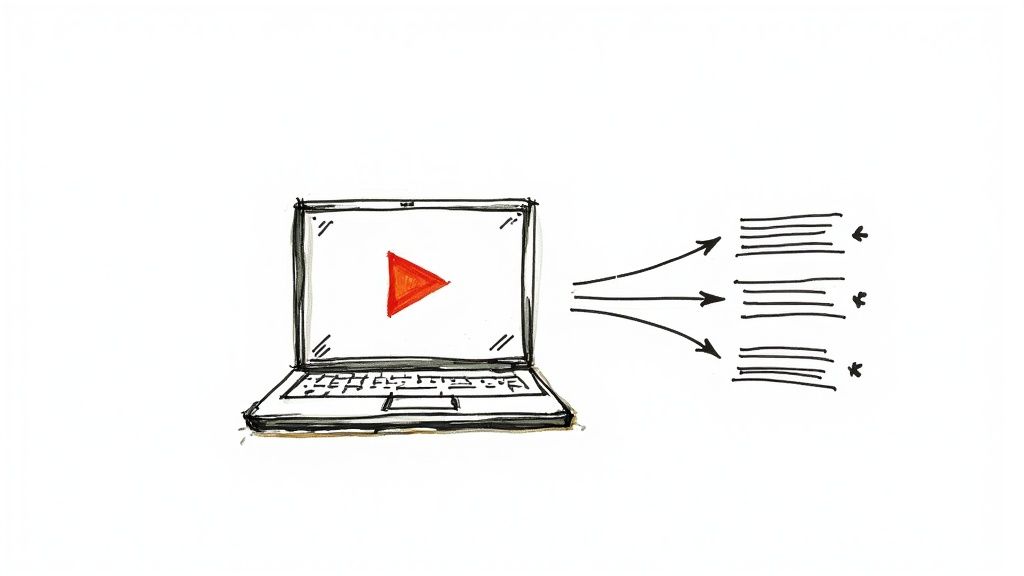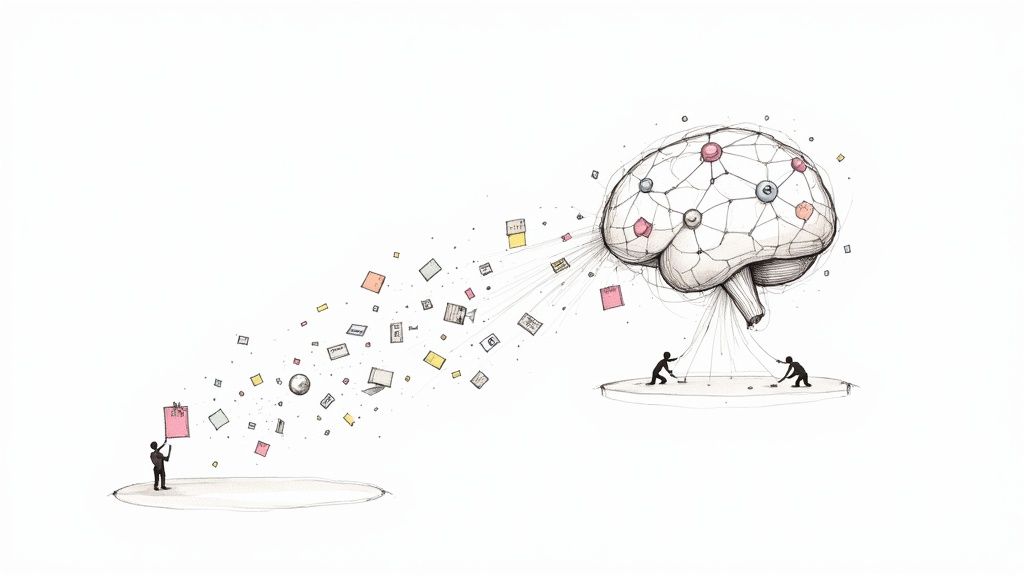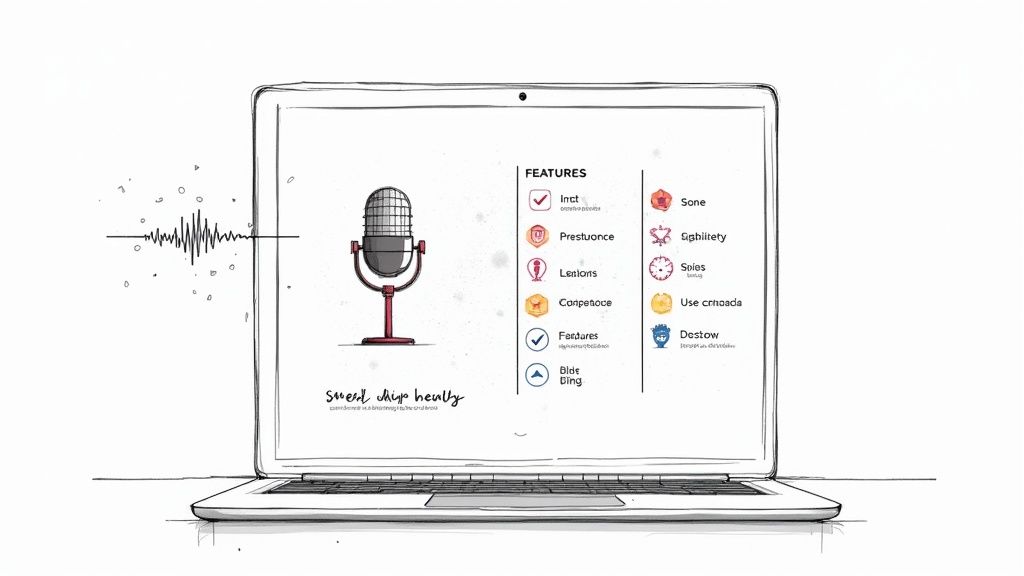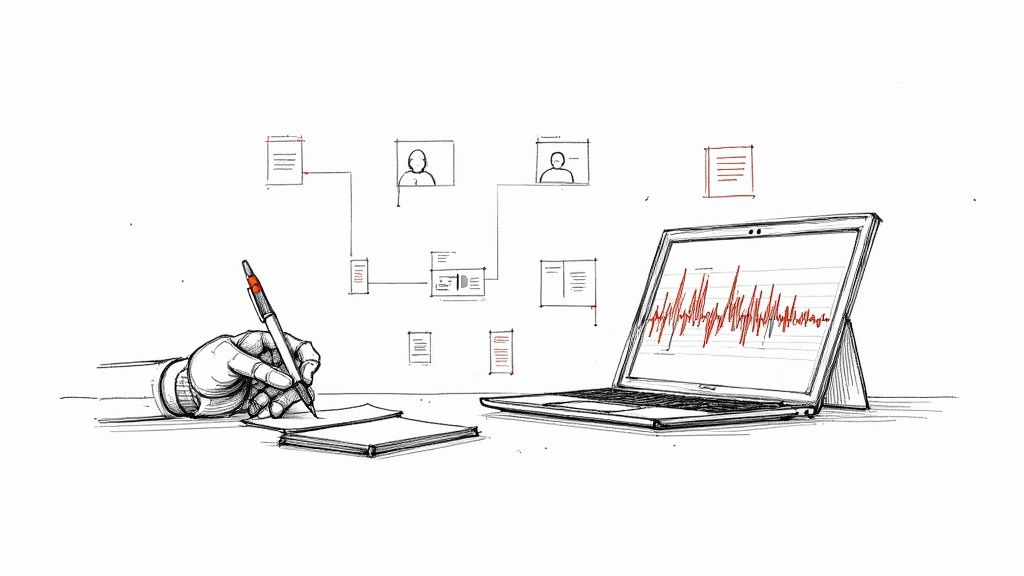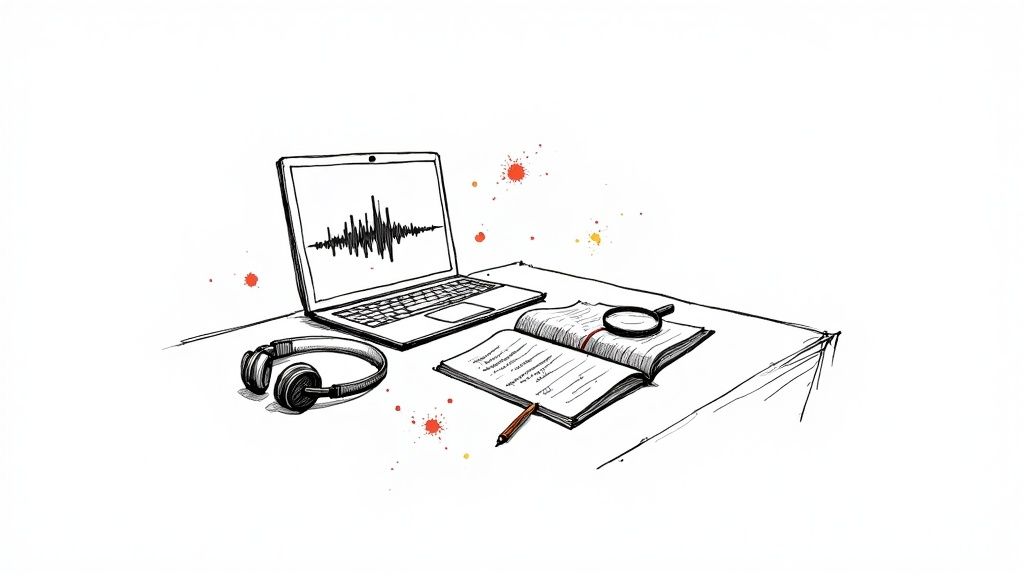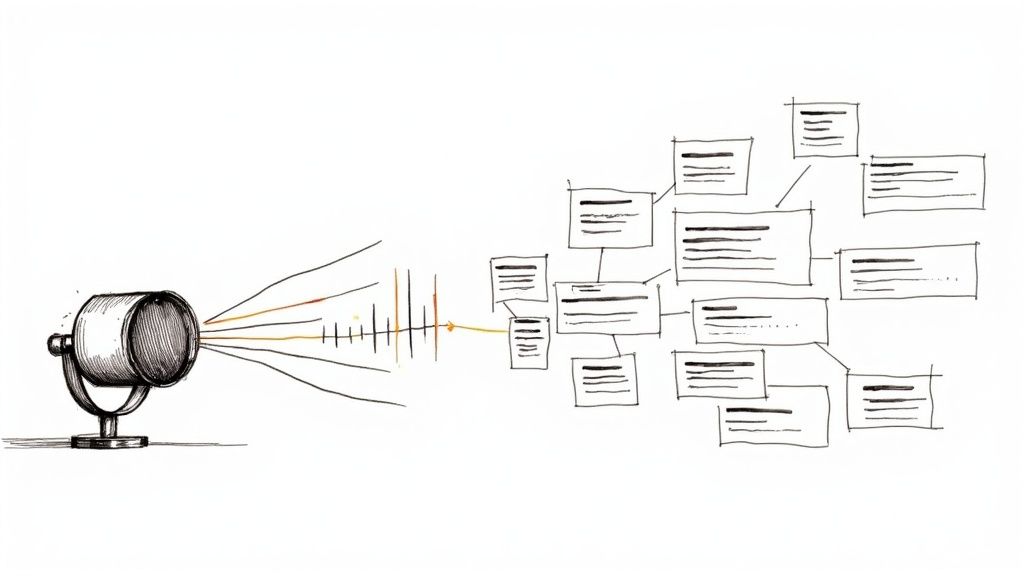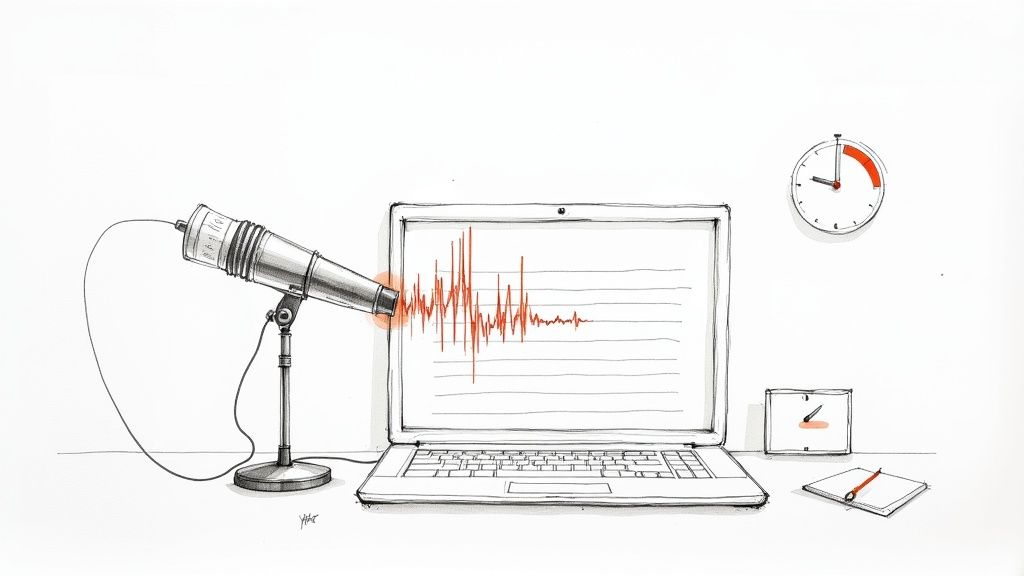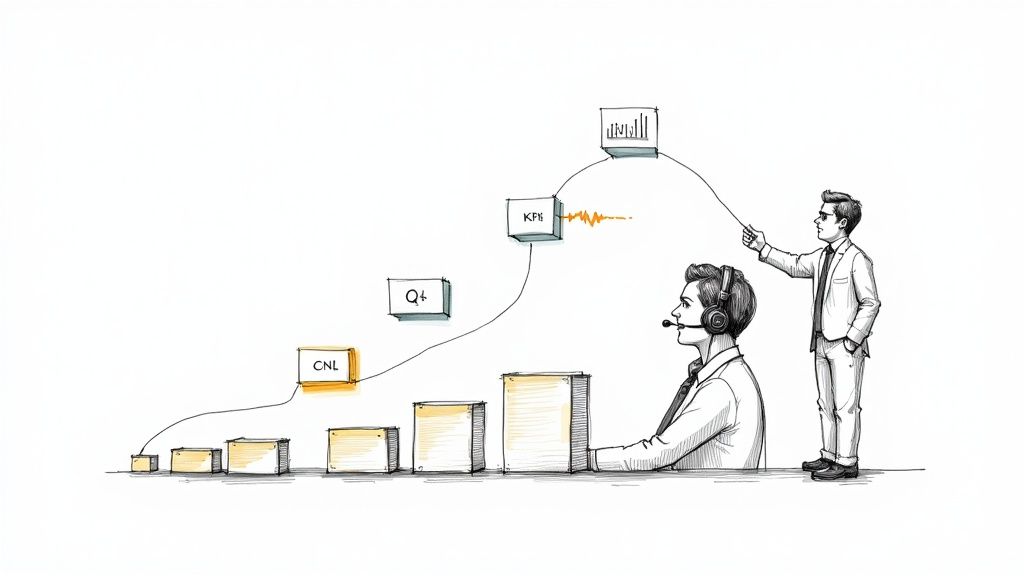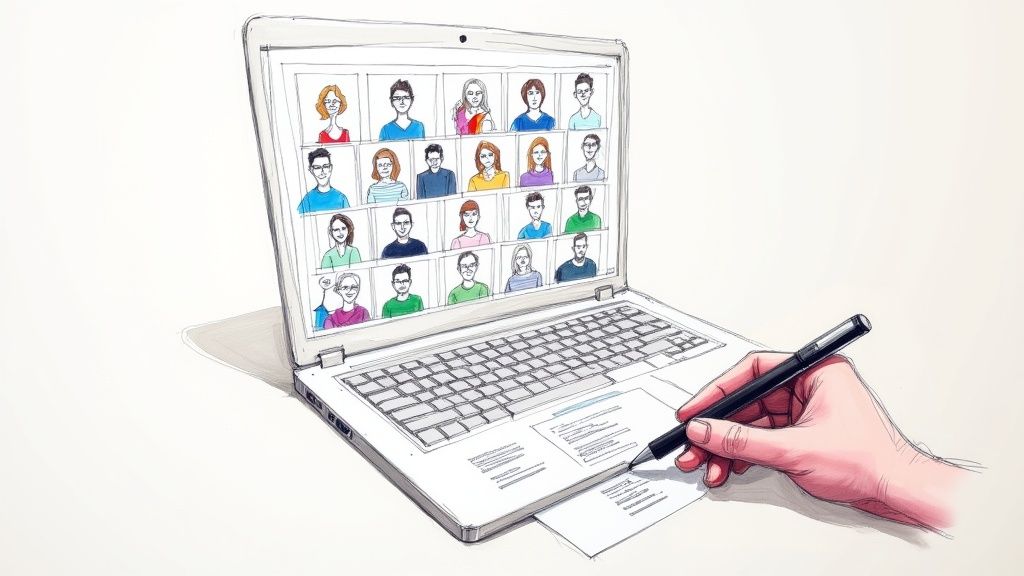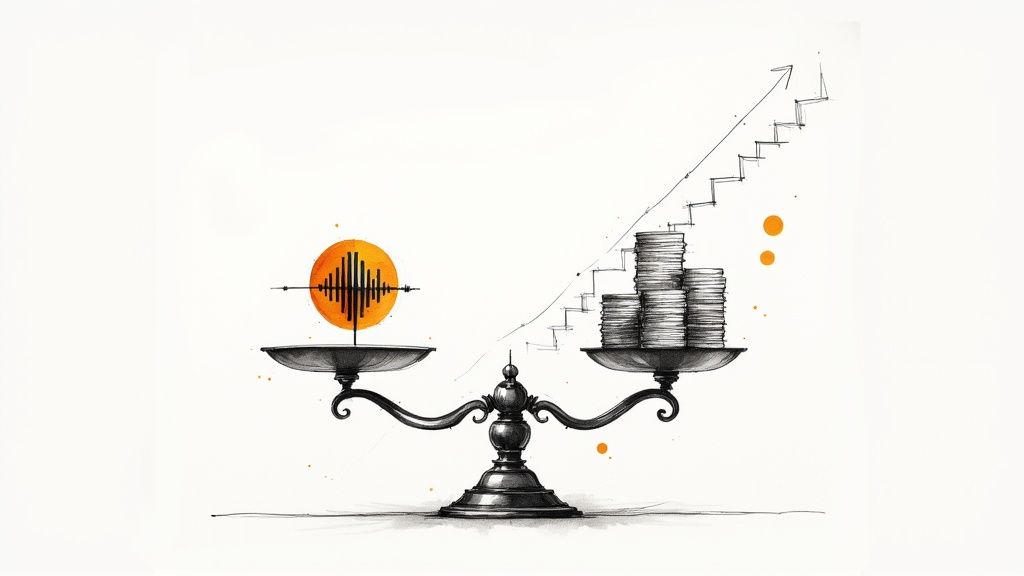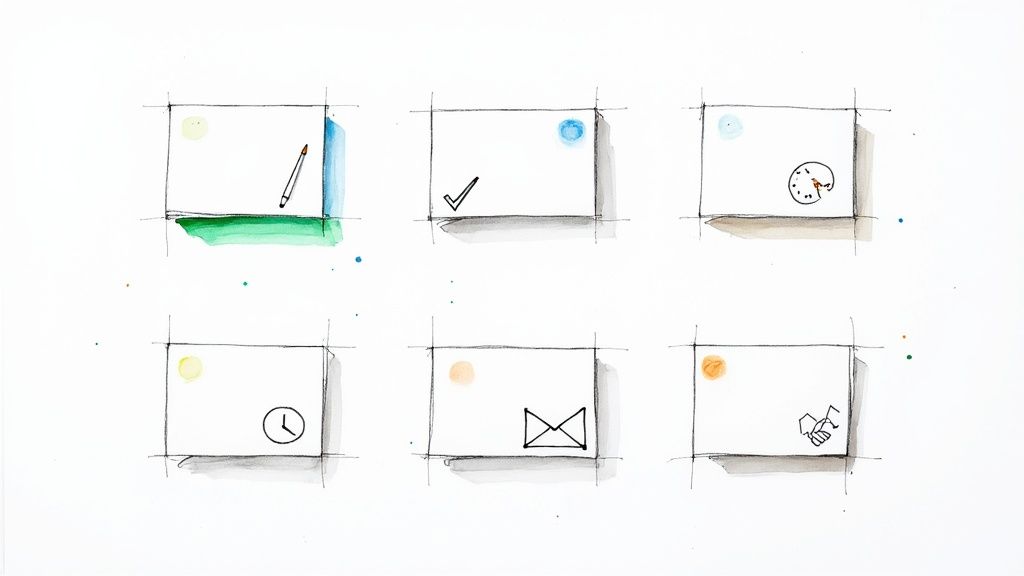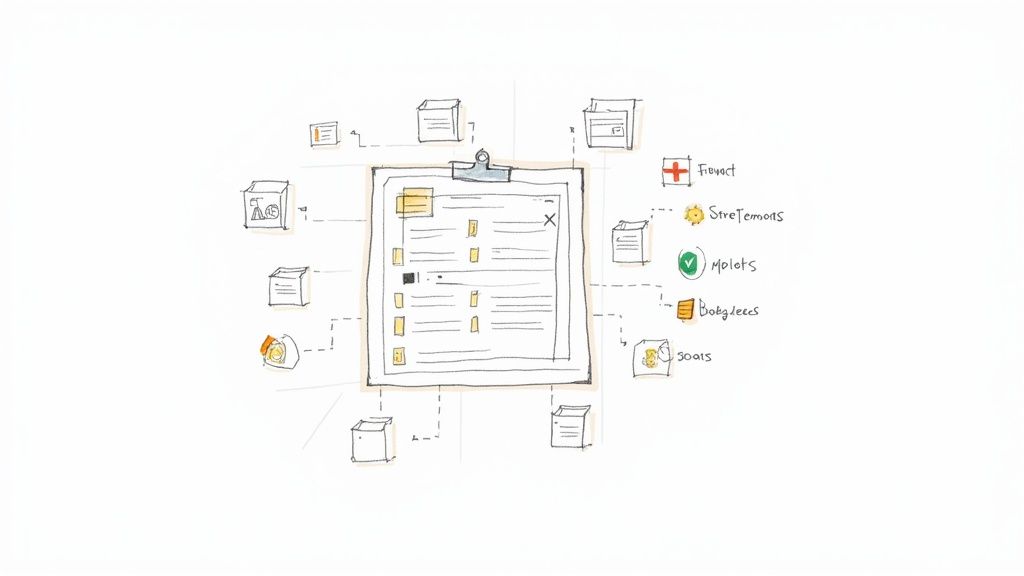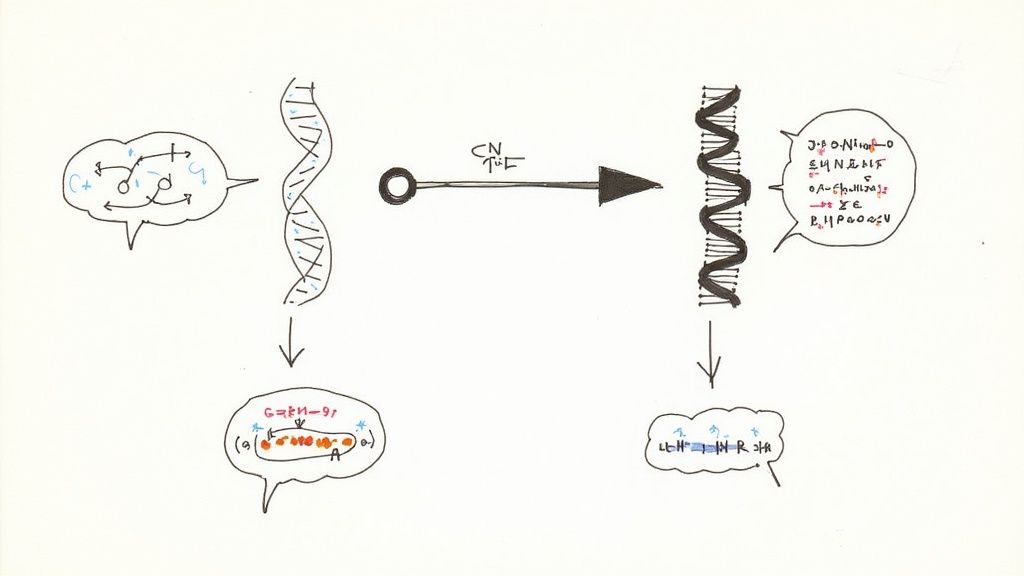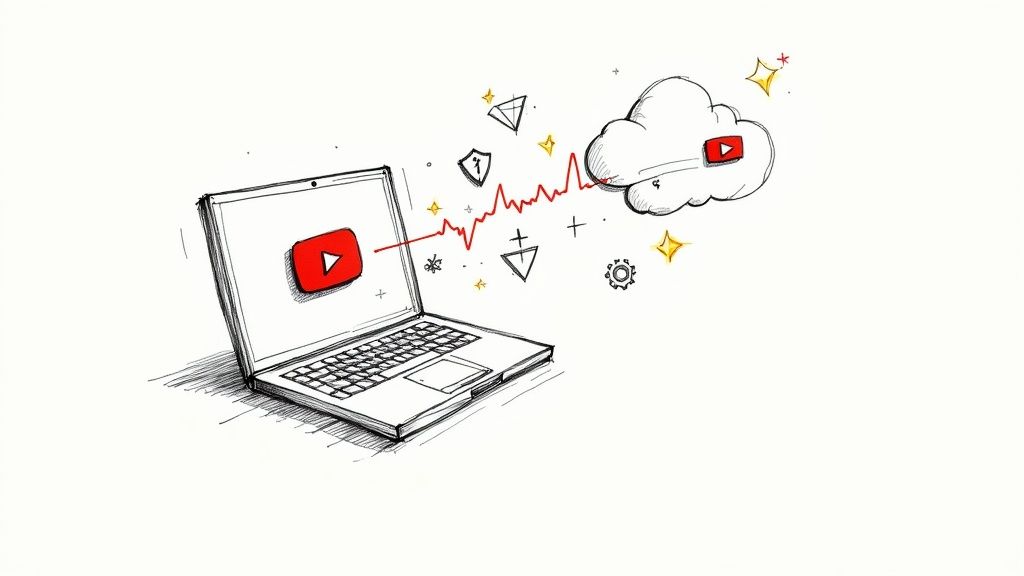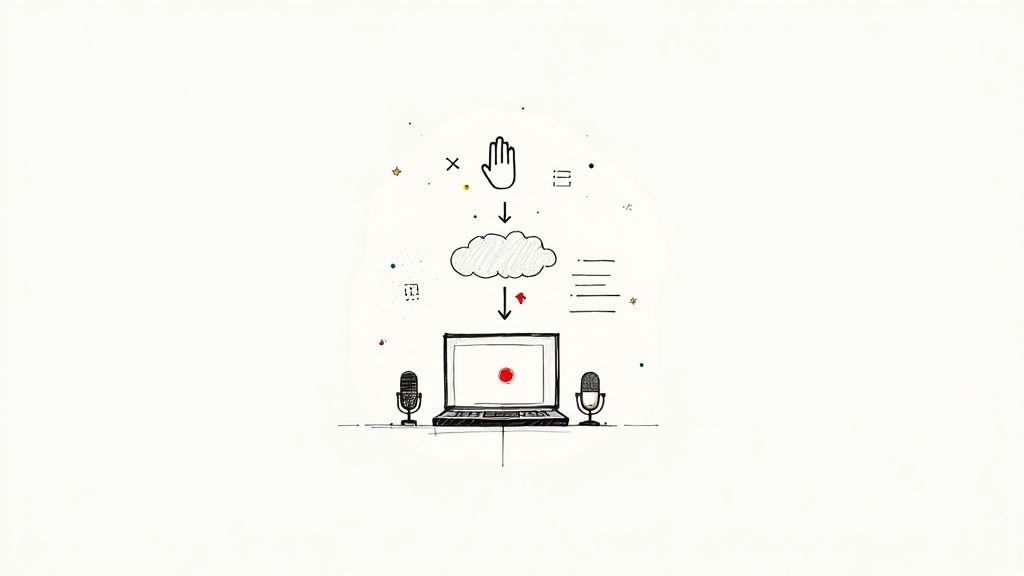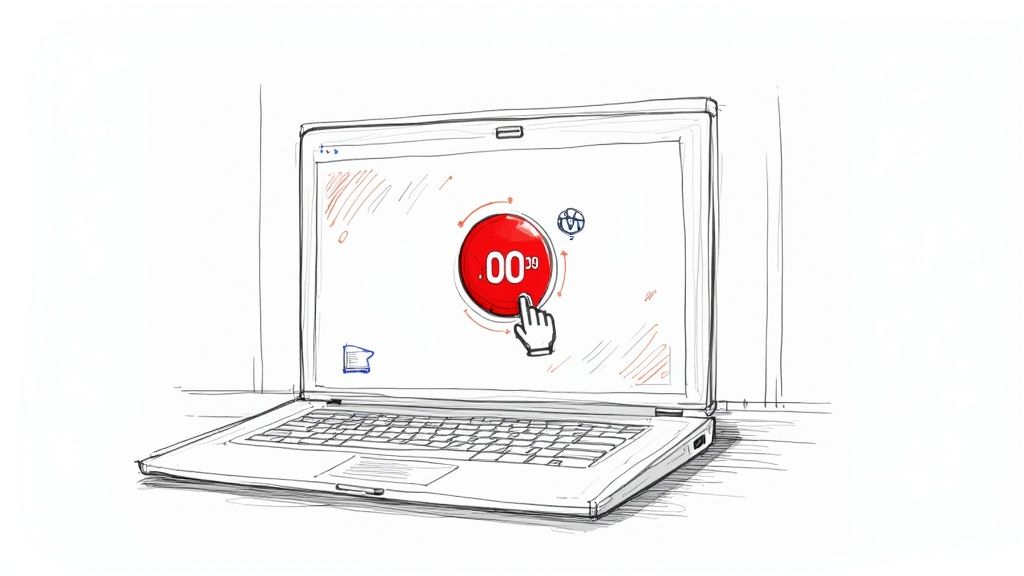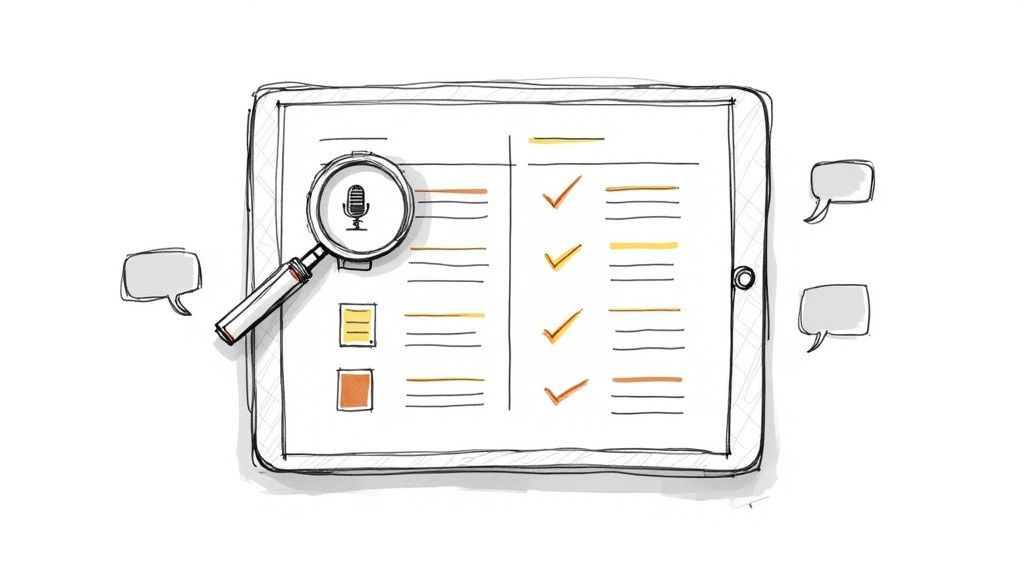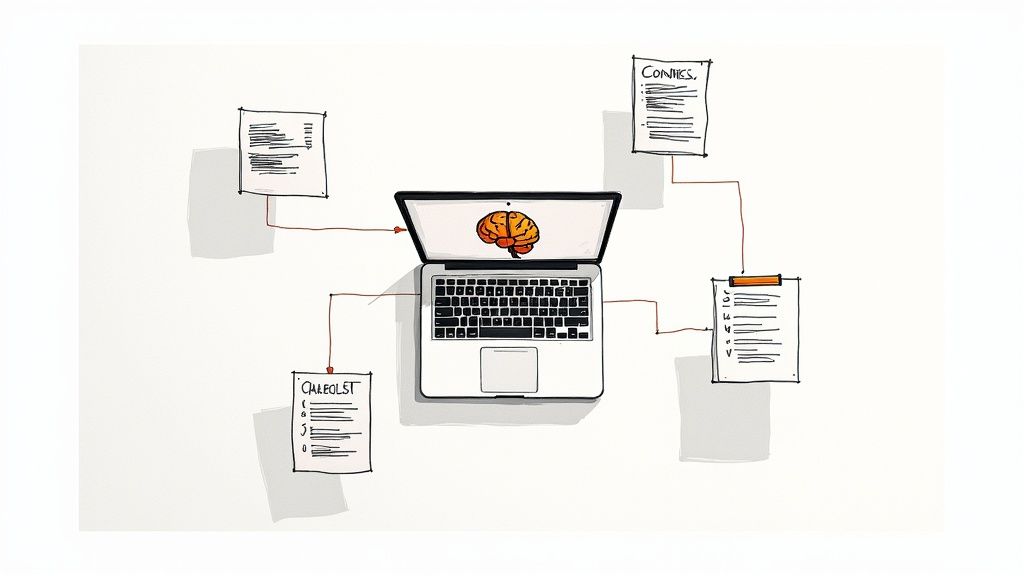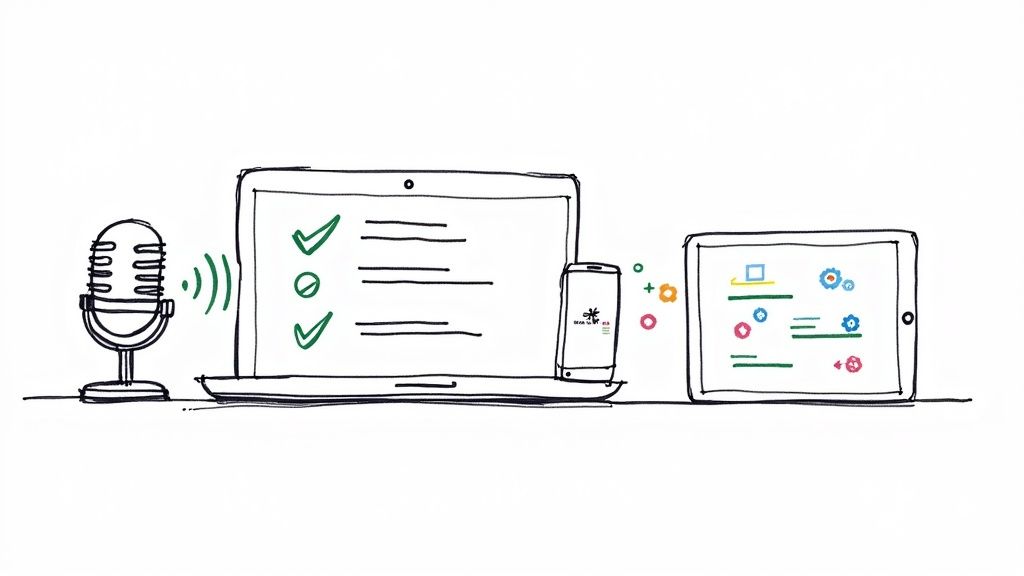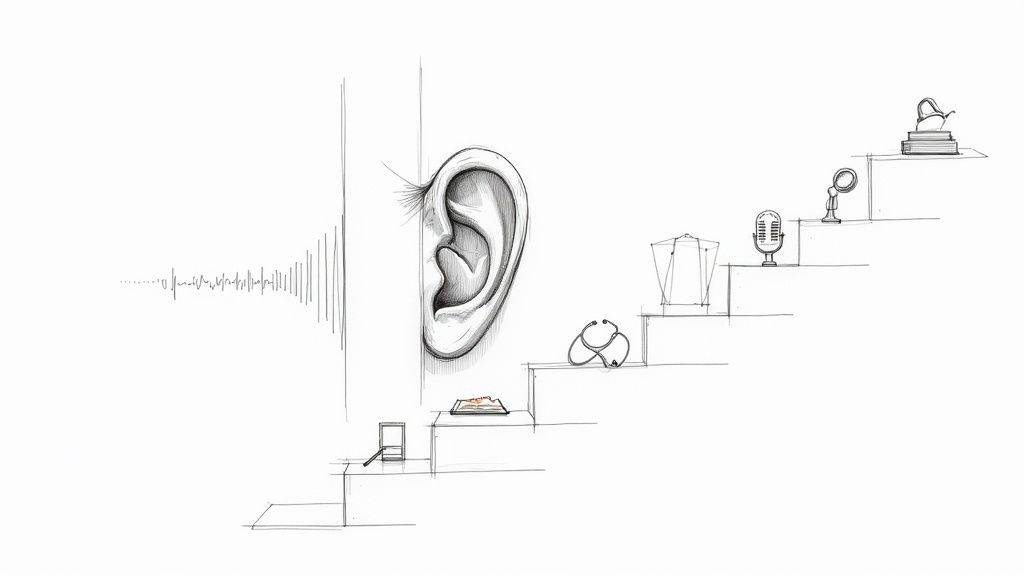How to Take Better Meeting Notes That Drive Action
We've all been there. You walk out of a meeting with a notebook crammed full of scribbles, but when you look back, you have no real clue what to do next. The secret to taking better meeting notes is a simple mental shift: stop being a passive transcriber and start acting like an active listener who captures decisions, actions, and key insights.
From my own experience, this one change transforms your notes from a messy, useless record into a genuine productivity tool.
Why Your Current Meeting Notes Aren’t Working

The real issue with most meeting notes isn't the template or the tool; it's the mindset. We often fall into the trap of thinking our job is to capture every single word, like a court stenographer. But this approach just buries the important stuff in a mountain of conversational fluff.
This habit kicks off a vicious cycle of inefficiency. Vague notes lead to confused team members, missed deadlines, and those dreaded follow-up meetings just to figure out what was actually decided in the first meeting. It's a massive drain on company time and energy. In fact, a staggering 24 billion hours are lost every year to unproductive meetings, often because they lack a clear purpose or outcome. You can dig deeper into the impact of unproductive meetings from Rev.com.
Truly effective note-taking isn't a chore; it’s a strategic activity. The goal is to create a clear, concise, and actionable summary that keeps the momentum going long after the meeting ends.
The Real Cost of Bad Notes
When meeting notes miss the mark, the consequences are felt across the entire team. A lack of clarity is just the start—the long-term damage is far worse. Here are a few things I've seen happen time and again from my own experience:
- Complete Team Misalignment: Everyone leaves with their own unique interpretation of what was agreed upon.
- Action Items Vanish: Critical tasks get dropped because no one clearly documented who was responsible or what the deadline was.
- Wasted Time and Energy: People spend hours tracking down information that should have been captured right there in the meeting.
The purpose of meeting notes isn't to remember what was said. It's to ensure everyone knows what to do next.
Let's look at the practical difference between these two mindsets.
The Shift from Passive Scribbling to Active Note-Taking
This table breaks down the small but powerful habits that separate notes that get forgotten from notes that get things done.
Moving from the habits on the left to the ones on the right is the first and most important step toward making every meeting more productive.
Get Ready Before the Meeting Even Begins
The secret to great meeting notes? It all starts before anyone even joins the call. Seriously. Just 15 minutes of prep work can completely change the game. Instead of frantically trying to type everything that’s said, you’ll be strategically capturing what actually matters.
This isn’t about doing hours of research. It’s about building a simple framework so you know exactly what to listen for. Think of it as creating a roadmap for the conversation before it even happens. This one habit is probably the single biggest lever you can pull to learn how to take better meeting notes that lead to real action.
Break Down the Agenda
First things first, pull up that meeting invitation and find the agenda. Don't just give it a quick glance—really dig into it. For every single item listed, I ask myself a few simple questions:
- What's the goal here? What are we trying to achieve with this topic?
- Are there any big decisions that need to be locked in?
- What kind of action items are likely to come out of this discussion?
Thinking this way gets your brain warmed up to spot the important stuff as it unfolds. I remember one project where this saved us from a huge setback. I saw "resource allocation" on the agenda and knew it was a potential bottleneck. By thinking about it beforehand, I was ready to push for a clear decision during the meeting, getting a name and a deadline assigned right then and there. That small bit of prep easily saved us a week of chasing people over email.
When you fill out your notes with the agenda items and your own questions beforehand, you’re not starting with a blank slate. You're starting with a strategic guide.
Know What You Need from the Meeting
Beyond the official agenda, what do you personally need to walk away with? Your goal might be totally different from the meeting's stated purpose. Maybe you need a specific stakeholder to sign off on a design, or you just need to understand how your task fits into the bigger picture.
Setting a personal objective acts like a filter for everything you hear. You stop being a passive listener and become an active participant, hunting for the specific information that matters to you. This also has a funny way of making the whole meeting run better. When everyone is focused, things move faster. Companies often track metrics like attendance and meeting length to improve efficiency, as discussed in this great post on meeting effectiveness from Superhuman. By having your own clear goal, you’re doing your part to keep the conversation sharp and productive.
Find the Right Note-Taking System for You
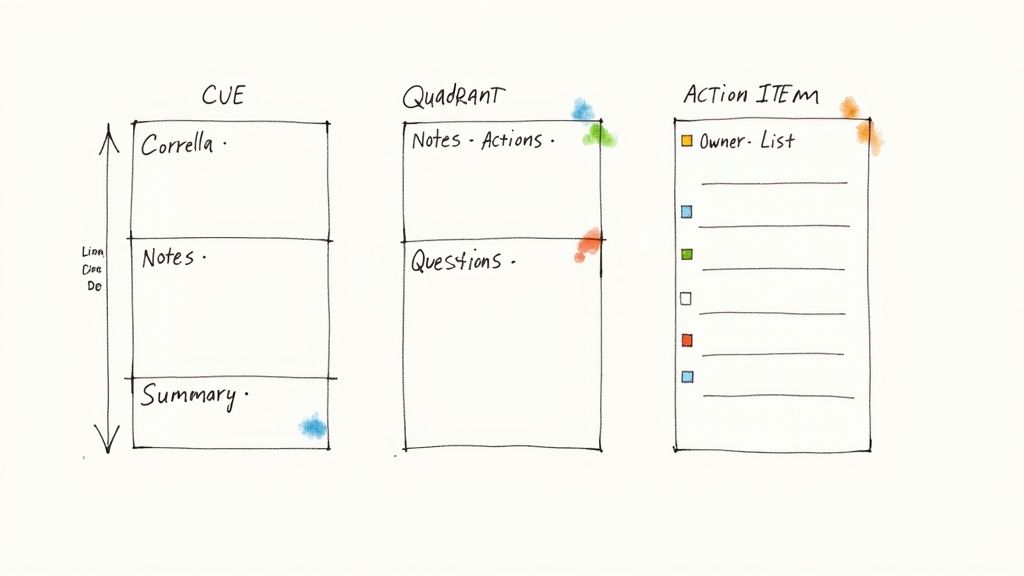
Let’s be honest, there’s no single "best" way to take notes. The perfect method is a myth. The right method, however, depends entirely on the type of meeting you're in and what you personally find effective.
The goal is to move beyond a blank page, which is often a recipe for a jumbled mess of thoughts. Having a few trusted systems in your back pocket lets you bring structure to the chaos, no matter what kind of meeting is on your calendar.
The Quadrant Method for Fast-Paced Discussions
This is my absolute go-to for project syncs and brainstorming sessions where ideas are flying fast. You just divide your page—digital or physical—into four simple boxes. This forces you to categorize information on the fly, which is incredibly efficient.
Here’s how I label mine:
- Notes: For the general flow of conversation and important context.
- Actions: Any specific task goes here. I always make sure to list who owns it and by when.
- Decisions: Crucial for documenting what was agreed upon so we don't have the same conversation next week.
- Questions: For parking lot items or things that need follow-up.
This layout keeps you focused on capturing outcomes, not just transcribing everything everyone says.
The Cornell Method for Deeper Analysis
Originally designed for university lectures, the Cornell Method is surprisingly powerful for complex meetings—think strategy deep dives or client discovery calls. You split your page into three sections: a main notes column on the right, a smaller cues column on the left, and a summary section at the very bottom.
During the meeting, all your detailed notes go into the main column. Right after, you review and pull out key ideas, questions, and important keywords into the left-hand cues column. The final step is to write a one or two-sentence summary of the whole meeting at the bottom.
This method forces you to actively process the information right away. That small step makes a huge difference in how much you actually remember and understand later on.
Comparing Popular Note-Taking Methods
Not sure which system to try first? Different meetings call for different approaches. Here’s a quick breakdown to help you match the method to the meeting.
Ultimately, experimenting is the only way to find what clicks for you. Try one method for a week, then switch it up.
Choosing Your Digital Companion
Of course, the system you choose is only half the equation. The tool you use it in matters, too. While I still love a good notebook, digital tools offer powerful search, easy sharing, and reusable templates.
Taking some time to explore the best meeting notes apps can help you find a platform that really complements your style and makes staying organized feel effortless.
Capture What Matters During the Meeting
https://www.youtube.com/embed/t2z9mdX1j4A
Once a meeting kicks off, your real job isn't to be a court stenographer, furiously typing every word. It's about active listening. The true art of taking great meeting notes lies in separating the conversational noise from the nuggets of gold—the key decisions and actions that move work forward.
This isn't always easy. With nearly half of us (46%) sitting in three or more meetings every single day, just staying focused can feel like a monumental task.
It’s this skill that makes a meeting worthwhile. While 55% of professionals believe meetings are productive, the other 45% see them as a drag on progress. Excellent notes are the bridge between those two realities, ensuring that talk translates directly into action. You can dig into more fascinating figures like these in these meeting statistics from archieapp.co.
Tune Your Ear for Trigger Phrases
If you want to immediately level up your note-taking, start training your ear to catch specific "trigger phrases." Think of these as verbal signposts that signal something important is coming—a decision, a new task, or a critical takeaway. When you hear one, it's your cue to start writing.
Keep an ear out for phrases like these:
- “So, the decision is…”
- “The next step here will be…”
- “Let’s agree to…”
- “Can you take responsibility for…”
Listening for these cues helps you cut through the chatter and automatically zero in on the information that truly matters.
Capture the Why Behind the What
Jotting down a decision is a good start, but great notes also explain why that decision was made. What were the other options? What was the context that led the team to this conclusion? Answering these questions turns your notes from a simple record into a strategic tool.
For example, instead of just writing, "Decision: Use Blue Widget," try something with more substance: "Decision: Use Blue Widget. Reasoning: Red Widget was over budget, and Green Widget was missing a key integration feature that engineering needed."
This extra layer of context is a lifesaver weeks down the line when someone inevitably asks, "Wait, why did we go with that option again?" It prevents the team from re-litigating old debates and keeps everyone aligned on the path forward.
Let AI Do the Heavy Lifting for Smarter Meeting Notes
Technology can be a game-changer for taking the grunt work out of meeting notes. Instead of furiously typing to catch every single word, you can let an AI assistant handle the transcription. Think of it as your partner, freeing you up to focus on the conversation itself.
This single shift changes everything. When you're not bogged down in transcription, you can actually pay attention to the subtext of the meeting. You can tune into unspoken agreements, gauge the room's energy, and jot down those critical nuances a machine will always miss. It’s a complete flip of the script on how to take better meeting notes, especially in those high-stakes, complex discussions.
From Raw Transcript to Polished Record
The real magic happens after the meeting ends. You’re not staring at a blank page. Instead, you have a detailed, searchable transcript ready to go. Your new role is to review and refine that raw output into something truly useful: a concise, actionable summary.
As you can see, tools like HypeScribe can turn a one-hour meeting into a manageable document in a matter of seconds.
From there, your review process should be quick and focused:
- Verify Key Decisions: Jump straight to the big decisions. Did the AI accurately capture what everyone agreed on? Make sure the final outcome is crystal clear.
- Clarify Action Items: Review the AI-generated tasks. Often, you'll need to add a bit of human touch here—assigning specific owners and setting firm deadlines if the AI didn’t catch them.
- Add Your Context: This is where you really shine. Add your observations about team morale, stakeholder concerns, or any "off-the-record" agreements that give the notes real meaning.
An AI assistant doesn't replace you. It elevates you. You stop being a scribe and become the strategic editor—the person who makes sense of it all for the rest of the team.
If you're ready to explore this further, our guide on choosing an AI meeting notes taker has more practical advice for weaving these tools into your daily workflow.
Turn Your Notes into Action After the Meeting
Let's be honest: notes are useless if they just die in a Google Doc. Their real power is in what happens after the meeting—driving action and making sure everyone is on the same page. To make that happen, I swear by what I call the "15-Minute Rule."
The moment a meeting wraps, I block out 15 minutes on my calendar. The goal is to tackle the notes while the conversation is still fresh. This isn't about transcribing every word; it's about quickly pulling out the most important stuff and giving it some structure.
This simple habit turns a jumble of thoughts into a clear, actionable plan.

Even with great tools, your final review is what makes the summary truly useful. You're the one who adds the human context.
Create a Shareable Summary
Whatever you do, don't just hit "share" on your raw, messy notes. Nobody has time to decipher those. Instead, you need to distill them into a quick summary that people will actually read. Think brief, scannable, and focused entirely on the outcomes.
A great summary should instantly answer three core questions for anyone who missed the meeting (or just zoned out):
- What did we decide?
- What are the next steps?
- Who is responsible for what, and by when?
By cleaning up and distributing a clear summary, you transform your notes from a personal archive into a public tool for accountability and momentum. This keeps projects moving forward.
If you need a solid framework to get started, our meeting follow-up template gives you a great structure to build from.
Got Questions About Taking Meeting Notes?
Even the most seasoned note-taker runs into tricky situations. You've got your system down, but then a curveball comes your way. Let’s walk through a few of the most common snags I've seen and how to handle them like a pro.
Mastering how to take better meeting notes is all about learning to adapt. Getting comfortable with these scenarios is a huge part of that.
What if There's No Meeting Agenda?
We've all been there: a mysterious meeting invite appears with no agenda attached. Don't just walk in blind. Be the person who brings the clarity.
Take a couple of minutes before the meeting to scan the title and the attendee list. From that, you can usually piece together a rough, three-point outline of what the meeting is likely about. Then, as the meeting kicks off, you can offer it up casually. Something like, "Hey, just to get us started, I jotted down a few potential goals. Does this feel right to everyone?" Not only does this save your own note-taking sanity, but it also gives the entire meeting a much-needed dose of focus.
How Detailed Should My Notes Be?
Here’s the golden rule: focus on outcomes, not conversations. Someone who missed the meeting should be able to read your notes and grasp three things immediately:
- What conclusions did we come to?
- What final decisions were made?
- What are the action items, who owns them, and what are the deadlines?
You're not a court reporter. Avoid the temptation to write down every "he said, she said." If a detail isn't a decision, an action item, or a crucial piece of context for one of those, it probably doesn't belong in the final summary.
Should I Take Notes by Hand or on a Laptop?
This is the classic debate, and honestly, it boils down to your personal preference and the meeting's vibe. Studies do show that writing by hand helps you remember things better. It forces your brain to process and summarize on the fly, which is fantastic for big-picture strategy sessions or creative brainstorms.
But let's be realistic—typing is way faster. It's also searchable and a breeze to share. For a rapid-fire, info-dump style of meeting where you just need to capture a lot of detail quickly, your laptop is probably your best friend.
At the end of the day, the right tool is whichever one lets you capture what’s important without pulling you out of the conversation.
How Can I Take Notes and Still Participate?
This is the ultimate multitasking challenge. The secret? Stop trying to do both at once.
While you're actively speaking and participating, just scribble down quick keywords or phrases. Think of them as breadcrumbs. Once the group has landed on a decision or a clear next step, that's your cue to switch back into note-taker mode and capture that specific outcome. If you’re the one running the meeting, do yourself a favor and delegate the note-taking. It’s nearly impossible to facilitate well and take great notes simultaneously.
Stop drowning in manual transcription. It's time to turn your meetings into momentum. With HypeScribe, you can get instant transcripts, AI-generated summaries, and organized action items from every single conversation. Give it a try for free and see what truly productive meetings feel like.



